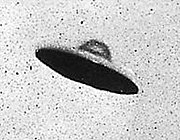
Apollo 9 was the third human spaceflight in NASA's Apollo program. Flown in low Earth orbit, it was the second crewed Apollo mission that the United States launched via a Saturn V rocket, and was the first flight of the full Apollo spacecraft: the command and service module (CSM) with the Lunar Module (LM). The mission was flown to qualify the LM for lunar orbit operations in preparation for the first Moon landing by demonstrating its descent and ascent propulsion systems, showing that its crew could fly it independently, then rendezvous and dock with the CSM again, as would be required for the first crewed lunar landing. Other objectives of the flight included firing the LM descent engine to propel the spacecraft stack as a backup mode, and use of the portable life support system backpack outside the LM cabin.

Extravehicular activity (EVA) is any activity done by an astronaut in outer space outside a spacecraft. In the absence of a breathable Earthlike atmosphere, the astronaut is completely reliant on a space suit for environmental support. EVA includes spacewalks and lunar or planetary surface exploration. In a stand-up EVA (SEVA), an astronaut stands through an open hatch but does not fully leave the spacecraft. EVAs have been conducted by the Soviet Union/Russia, the United States, Canada, the European Space Agency and China.

Neil Alden Armstrong was an American astronaut and aeronautical engineer who in 1969 became the first person to walk on the Moon. He was also a naval aviator, test pilot, and university professor.

Edward Higgins White II was an American aeronautical engineer, United States Air Force officer, test pilot, and NASA astronaut. He was a member of the crews of Gemini 4 and Apollo 1.
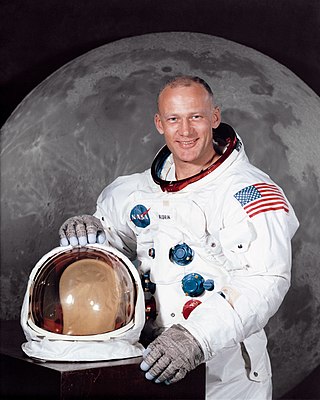
Buzz Aldrin is an American former astronaut, engineer and fighter pilot. He made three spacewalks as pilot of the 1966 Gemini 12 mission, and was the Lunar Module Eagle pilot on the 1969 Apollo 11 mission. He was the second person to walk on the Moon after mission commander Neil Armstrong.

Michael Collins was an American astronaut who flew the Apollo 11 command module Columbia around the Moon in 1969 while his crewmates, Neil Armstrong and Buzz Aldrin, made the first crewed landing on the surface. He was also a test pilot and major general in the U.S. Air Force Reserve.

David Randolph Scott is an American retired test pilot and NASA astronaut who was the seventh person to walk on the Moon. Selected as part of the third group of astronauts in 1963, Scott flew to space three times and commanded Apollo 15, the fourth lunar landing; he is one of four surviving Moon walkers and the only living commander of a spacecraft that landed on the Moon.
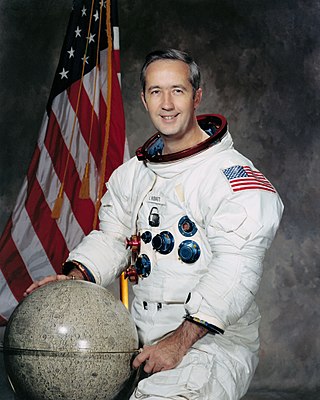
James Alton McDivitt Jr. was an American test pilot, United States Air Force (USAF) pilot, aeronautical engineer, and NASA astronaut in the Gemini and Apollo programs. He joined the USAF in 1951 and flew 145 combat missions in the Korean War. In 1959, after graduating first in his class with a Bachelor of Science degree in Aeronautical Engineering from the University of Michigan through the U.S. Air Force Institute of Technology (AFIT) program, he qualified as a test pilot at the Air Force Experimental Flight Test Pilot School and Aerospace Research Pilot School, and joined the Manned Spacecraft Operations Branch. By September 1962, McDivitt had logged over 2,500 flight hours, of which more than 2,000 hours were in jet aircraft. This included flying as a chase pilot for Robert M. White's North American X-15 flight on July 17, 1962, in which White reached an altitude of 59.5 miles (95.8 km) and became the first X-15 pilot to be awarded Astronaut Wings.

Salizhan Shakirovich Sharipov is a Kyrgyz cosmonaut of Uzbek descent. Sharipov is a co-author and investigator for the Advanced Diagnostic Ultrasound in Microgravity project. He has been to space twice and has conducted two space walks. Sharipov retired on 18 July 2008.

NASA Astronaut Group 2, also known as the Next Nine and the New Nine, was the second group of astronauts selected by the National Aeronautics and Space Administration (NASA). Their selection was announced on September 17, 1962. The group augmented the Mercury Seven. President John F. Kennedy had announced Project Apollo, on May 25, 1961, with the ambitious goal of putting a man on the Moon by the end of the decade, and more astronauts were required to fly the two-man Gemini spacecraft and three-man Apollo spacecraft then under development. The Mercury Seven had been selected to accomplish the simpler task of orbital flight, but the new challenges of space rendezvous and lunar landing led to the selection of candidates with advanced engineering degrees as well as test pilot experience.
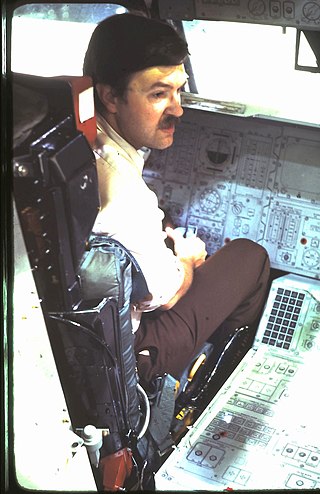
James Edward Oberg is an American space journalist and historian, regarded as an expert on the Russian and Chinese space programs. He had a 22-year career as a space engineer in NASA specializing in orbital rendezvous. Oberg is an author of ten books and more than a thousand articles on space flight. He gave many explanations of UFO phenomena in the popular press. He is also a consultant in spaceflight operations and safety.

NASA Astronaut Group 3—'The Fourteen'—was a group of fourteen astronauts selected by NASA for the Gemini and Apollo program. Their selection was announced in October 1963. Seven were from the United States Air Force, four from the United States Navy, one was from the United States Marine Corps and two were civilians. Four died in training accidents before they could fly in space. All of the surviving ten flew Apollo missions; five also flew Gemini missions. Buzz Aldrin, Alan Bean, Gene Cernan and David Scott walked on the Moon.
A mission patch is a cloth reproduction of a spaceflight mission emblem worn by astronauts and other personnel affiliated with that mission. It is usually executed as an embroidered patch. The term space patch is mostly applied to an emblem designed for a crewed space mission. Traditionally, the patch is worn on the space suit that astronauts and cosmonauts wear when launched into space. Mission patches have been adopted by the crew and personnel of many other space ventures, public and private.

The NASA Astronaut Corps is a unit of the United States National Aeronautics and Space Administration (NASA) that selects, trains, and provides astronauts as crew members for U.S. and international space missions. It is based at Johnson Space Center in Houston, Texas.

Neutral buoyancy simulation with astronauts immersed in a neutral buoyancy pool, in pressure suits, can help to prepare astronauts for the difficult task of working while outside a spacecraft in an apparently weightless environment.
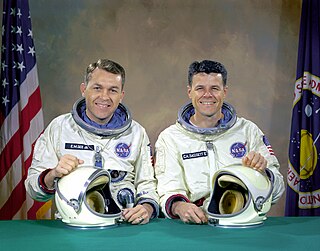
On February 28, 1966, a NASA Northrop T-38 Talon crashed at Lambert Field in St. Louis, Missouri, killing two Project Gemini astronauts, Elliot See and Charles Bassett. The aircraft, piloted by See, crashed into the McDonnell Aircraft building where their Gemini 9 spacecraft was being assembled. The weather was poor with rain, snow, fog, and low clouds. A NASA panel, headed by the Chief of the Astronaut Office, Alan Shepard, investigated the crash. While the panel considered possible medical issues or aircraft maintenance problems, in addition to the weather and air traffic control factors, the end verdict was that the crash was caused by pilot error.
A space jellyfish is a rocket launch-related phenomenon caused by sunlight reflecting off the high-altitude rocket plume gases emitted by a launching rocket during morning or evening twilight. The observer is in darkness, while the exhaust plumes at high altitudes are still in direct sunlight. This luminous apparition is reminiscent of a jellyfish. Sightings of the phenomenon have led to panic, fear of nuclear missile strike, and reports of unidentified flying objects.
